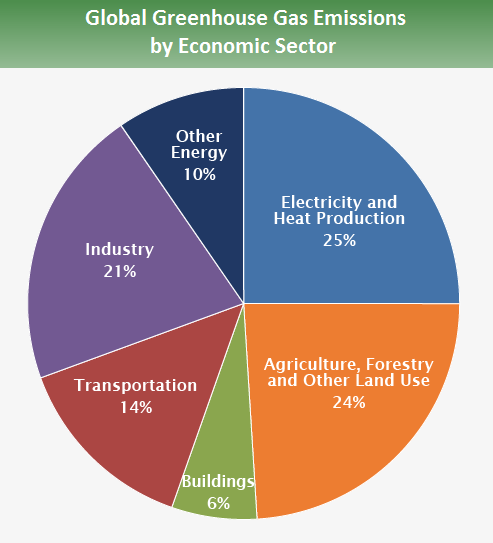Although they may seem like two different issues, climate change and air pollution are closely linked; in UNEP’s words, these two issues are two sides of the same coin (UNEP, 2019). Air pollutants and greenhouse gases are one of the most critical concerns of our age, leading to climate change and causing health problems worldwide. Many factors contribute to their increase. Besides natural causes, we produce and consume more than ever before, and as a result, we also contribute to air pollution and global warming through our lifestyles (UNEP, 2019).

Air pollution and climate change have many familiar sources. However, the increase in air pollutants and greenhouse gas emissions that trigger climate change, population growth, industrialization/industrial activities, energy need, an increase in the use of motor vehicles, and the need brought by urbanization/urbanization are the factors that come to the fore (Değirmenci & Yavuz, 2021).
What is a greenhouse gas?
Greenhouse gases occur naturally in the atmosphere. According to the Environmental Protection Agency (EPA), the most important greenhouse gases are water vapor (H2O), carbon dioxide (CO2), methane (CH4), and nitrous oxide (N2O). Greenhouse gases that trap heat from the sun have made Earth’s climate habitable for humans and millions of other species. Without these gases, Earth’s average surface temperature would drop from about 14°C to minus 18°C (Care4Air).
The exchange of incoming and outgoing radiation that warms the Earth is often called the greenhouse effect. The most significant cause of greenhouse gas emissions is using fossil fuels as an energy source. The increase in the amount of CO2 and other heat-trapping greenhouse gases causes the temperature in the atmosphere to rise, which is called “global warming.” This has serious consequences, such as melting glaciers and rising oceans (Nuclear Academy, 2022).

The most common greenhouse gas in the atmosphere, CO2, has the most significant heat-holding capacity. Today, CO2 is the primary greenhouse gas, responsible for about three-quarters of emissions (EPA, 2022). Carbon dioxide emissions originate mainly from burning organic matter: coal, oil, gas, wood, and solid waste (National Geographic, 2019). Another primary source of CO2 is deforestation. According to NASA’s Global Climate Change portal, CO2 has increased by about 50% since the Industrial Revolution began in the 1750s (NASA, 2022).

According to the United Nations Framework Convention on Climate Change (UNFCCC), methane is about 21 times more effective at absorbing radiation than CO2. Although methane and other greenhouse gases are more capable of trapping heat than CO2, scientists still think carbon dioxide is the dominant greenhouse gas because its warming effect has outlasted the impact of others for centuries (Live Science, 2022).

The Framework Convention on Climate Change focuses on stopping or reducing greenhouse gases, especially CO2 emissions, which are believed to cause global warming.
Greenhouse gases have a wide range of environmental and health effects. By trapping heat, they cause climate change and contribute to respiratory diseases from smoke and air pollution (National Geographic, 2019).
What is air pollution?
Emissions are air pollutants that leave the facility that produces them and enter the atmosphere. These pollutants are generally collected in two subgroups gaseous (SO2, NOx, HC, CO, CO2) and dust (smoke, metallic smoke, fly ash, mist, aerosols). Apart from this, photochemical oxidants such as ozone (O3) and PAN (peroxy acetyl nitrate), and PBN (peroxybenzole nitrate) are also defined as secondary air pollutants (Sahakk-i, 2022).
Air pollutant sources are handled in two classes, natural sources and human activities (anthropogenic) sources. The primary anthropogenic sources are transportation, industry, and heating (EPA, 2020).
Air movements can transport these various pollutants in solid, liquid, and gas phases over long distances. Wind speed, direction, air humidity, solar radiation, precipitation, and geomorphological conditions affect the spread of pollutants around the emission source. In addition, these substances enter the water and soil structure after a certain period and cause the environmental conditions in these environments to change (Ankara University)

Air pollution is now the world’s fourth most significant risk factor for premature death (The World Bank, 2016).
Prolonged and high levels of exposure to these pollutants cause a wide range of effects, from adverse respiratory system effects to premature death. The climate crisis threatens to significantly worsen air pollution problems if we do not take action to reduce carbon pollution (Ankara University).

As a result of the use of coal, substances such as SO2 and NOx released from the flue gas and dust particles cause air pollution. In addition, acid rain can occur when these substances increase too much in the atmosphere (Nuclear Academy, 2022). Therefore, the best and most effective way to control air pollution is by accelerating our transition to cleaner fuels and industrial processes.
Focusing on the relationship between greenhouse gas reduction and local air pollutant control is essential.
Air pollution causes climate change, and climate change causes air quality to change. Due to climate warming, the Earth is experiencing more extreme weather, such as heat waves and droughts, which can adversely affect air quality. Heat waves cause an increase in ground-level ozone pollution as the chemical reactions that create ozone in the atmosphere occur more frequently in hot weather (UCAR).
During heat waves, high-pressure areas create stagnant air that concentrates air pollutants in a room. Prolonged high temperatures due to climate warming often lead to drought conditions where wildfires, which release carbon monoxide and particulates, become more common. During hot weather periods, dry, dusty air also increases the amount of particulate pollution (UCAR).
While many particulate and gaseous emissions contribute to climate change and air pollution, a lack of coordination between climate change mitigation and air quality management processes can result in inefficient, unnecessarily slow, or discrete efforts to curb the sources of these emissions. Interventions aimed at reducing them simultaneously can be cost-effective, optimize outcomes, and produce better results than addressing them separately (C40, 2021).
The key here is to reduce carbon emissions. A person worldwide has an average of four tons of carbon footprint. Individuals have many responsibilities (Wellness Design Center, 2020).
How Do You Protect Your Health? How Can You Reduce Your Carbon Footprint?
- If you’re exercising outside, stay away from high-traffic roads as much as possible. Then take a shower and wash your clothes to remove fine particles.
- The air may seem clean, but that doesn’t mean it’s clean. Take advantage of tools like air pollution monitoring to get the latest conditions. If the air quality is poor, stay indoors with the windows closed.
- Walk, bike, or use public transport whenever possible
- Keep a small stock of masks to wear when conditions are bad
- You can request that your electricity be provided by the wind or the sun
- reduce flight travel
- Pay attention to energy efficiency in the home
- Buying your groceries locally reduces the fossil fuels burned in transporting or flying food around the country
References
C40. (2021). Clean Air, Healthy Planet.
Değirmenci, T., & Yavuz, H. (2021). The Relationship between Air Pollution, Health Expenditures, and Economic Growth in UN Countries with Emission Reduction Responsibility. Eskişehir Osmangazi University Journal of Economics and Administrative Sciences 16(3), s. 856-872.
Ankara University, (2022).
Care4Air, (2022).
EPA, (2020).
EPA, (2022).
Live Science, (2022).
NASA, (2022).
National Geographic, (2019).
Nuclear Academy, (2022).
The World Bank, (2016).
UCAR, (2022).
UNEP, (2019).








